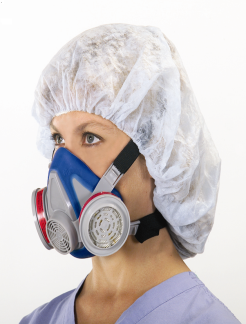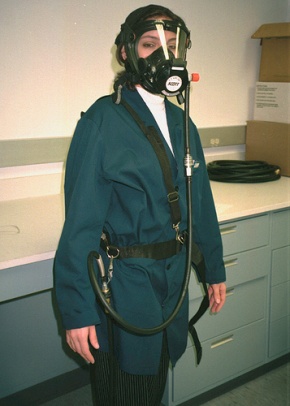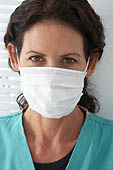Form 6 Chemical Sterilants
Survey of Healthcare Workers' Health and Safety Practices
Attachment I5_Module D_TC_72310
Healthcare Workers Primary Hazard Module
OMB: 0920-0860
MODULE D: Chemical Sterilants Form Approved
7/23/10 OMB No. 10AP-xxxx
Expiration Date: xx/xx/2011
PROGRAMMING INSTRUCTIONS APPEAR IN BLUE.
INTRO QUESTIONS |
|||
A. |
Did you sterilize medical instruments or supplies using ETHYLENE OXIDE (EtO in the past 7 calendar days)?
d
|
|
|
|
|||
B. |
Did you sterilize medical instruments or supplies using HYDROGEN PEROXIDE GAS PLASMA in the past 7 calendar days?
|
|
|
QUESTION C IS TO BE COMPLETED BEFORE DISPLAYING SUBMODULEs
|
|||
C. |
From which organization(s) have you achieved professional certification for sterile processing of medical instruments or supplies?
Please all that apply. |
|
|
IF Respondent MARKED ‘YES’ TO INTRO QUESTIONS A AND B, RANDOMIZE ORDER SUBMODULES ARE PRESENTED. IF Respondent MARKed ‘YES’ TO ONLY ONE OF THESE TWO QUESTIONS è go TO APPROPRIATE SUBMODULE. |
|||
EtO Sterilizer with IN-CHAMBER Aeration |
|||||
|
|
During the past 7 calendar days, did you sterilize medical instruments or supplies using an EtO sterilizer with in-chamber aeration (i.e., load does not need to be transferred after sterilization to a separate aerator)?
Note: Check “Not applicable” if your workplace does not have this type of EtO sterilizer.
|
|
|
||
|
|||||
|
|
During the past 7 calendar days, what was the total number of loads you processed using an EtO sterilizer with in-chamber aeration?
|
|
|
||
|
|||||
|
|
During the past 7 calendar days, the total number of loads you processed using an EtO sterilizer with in-chamber aeration was… |
|
|
||
|
|||||
|
|
What was the source of EtO gas for the sterilizer with in-chamber aeration you used most often during the past 7 calendar days?
|
|
|
||
|
|||||
|
|
Which best describes the location of the EtO supply gas cylinder for the sterilizer with in-chamber aeration you used most often during the past 7 calendar days?
|
|
|
||
|
|||||
|
|
Considering the EtO sterilizer with in-chamber aeration you used most often during the past 7 calendar days…
|
Yes |
No |
I don’t know |
|
a. …was operational local exhaust ventilation provided above the door of the sterilizer? |
¦ |
¦ |
¦ |
||
b. …was there a continuous monitor located near the sterilizer that provides a warning when EtO leaks occur? |
¦ |
¦ |
¦ |
||
EtO Sterilizer with SEPARATE Aeration Chamber |
|||||
|
|
During the past 7 calendar days, did you use an EtO sterilizer with a separate aeration chamber (i.e., load needs to be transferred after sterilization to a separate aerator)?
Note: Check “Not applicable” if your workplace does not have this type of EtO sterilizer. |
|
|
||
|
|||||
|
|
During the past 7 calendar days, how much time did you typically spend transferring a single load from a sterilizer to the aeration chamber?
Note: Include only the time spent transferring the load from the sterilizer to the aeration chamber.
|
|
|
||
|
|||||
|
During the past 7 calendar days, what was the total number of loads transferred from the sterilizer to the aeration chamber?
|
|
|
||
|
|||||
|
|
During the past 7 calendar days, the total number of loads you transferred from the sterilizer to the aeration chamber was…
|
|
|
||
|
|||||
|
|
What was the source of EtO gas for the sterilizer with separate aeration chamber you used most often during the past 7 calendar days?
|
|
|
||
|
|||||
|
|
Which best describes the location of the EtO supply gas cylinder or container for the sterilizer with a separate aeration chamber you used most often during the past 7 calendar days?
|
|
|
||
|
|||||
|
|
Considering the sterilizer with a separate aeration chamber that you used most often during the past 7 calendar days…..
|
Yes |
No |
I don’t know |
|
a. Was operational local exhaust ventilation provided above the door of the sterilizer? |
¦ |
¦ |
¦ |
||
b. Was there a continuous monitor located near the sterilizer that provides a warning when EtO leaks occur? |
¦ |
¦ |
¦ |
||
EtO Sterilizer System Using Glass Ampoules of Liquid EtO
|
|
|
|
|||||||||||||||
|
|
During the past 7 calendar days, did you sterilize medical instruments or supplies with a sterilizer system that uses glass ampoules containing liquid ethylene oxide (e.g., Anprolene®)?
Note: Check “Not applicable” if your workplace does not have this type of ethylene oxide sterilizer.
|
|
|
|
|
|
||||||||||||
|
|
|
|
|||||||||||||||
|
|
During the past 7 calendar days, what was the total number of loads you processed with this type of sterilizer system?
|
|
|
|
|
|
||||||||||||
|
|
|
|
|||||||||||||||
|
|
During the past 7 calendar days, the total number of loads you transferred from the sterilizer to the aeration chamber was… |
|
|
|
|
|
||||||||||||
|
|
|
|
|||||||||||||||
|
|
How often do you place the sealed plastic bag(s) in the sterilizer after breaking the glass ampoule? |
|
|
|
|
|
||||||||||||
|
|
|
|
|||||||||||||||
|
|
Was the sterilizer system that uses glass ampoules containing liquid EtO connected to an exhaust source?
|
|
|
|
|
|
||||||||||||
|
|
|
|
|||||||||||||||
|
|
Was there a continuous monitor located near this sterilizer system that provides a warning when EtO leaks occur? |
|
|
|||||||||||||||
Questions addressing work practices and use of personal protective equipment (PPE) will help us understand what is currently used around EtO sterilizer systems and under what circumstances. Depending on your job and exposures, PPE may not be required.
|
|
|
|
|||||||||||||||
if respondent marked ‘single-use cartridge’ in Question 12 or question 19, skip questions 28-37. if respondent marked ‘gas cylinder(s)’ in question 12 or question 19, skip questions 28-30. |
|
|
|
|||||||||||||||
|
|
During the past 7 calendar days, how often did you wear protective gloves while sterilizing medical instruments with this type of sterilizer system?
|
|
|
|
|
|
||||||||||||
|
|
|
|
|||||||||||||||
|
|
What were the reasons(s) you did not always wear protective gloves while sterilizing medical instruments or supplies with this type of sterilizer system? Please ü all that apply.
|
|
|
|
|
|
||||||||||||
if respondent marked only one reason in question 29 and ‘never’ in question 28 è go to Question 31. if respondent marked only one reason in question 29 and marked ‘sometimes’ in question 28 è go to Question 31. |
|
|
|
|||||||||||||||
|
|
Of the reasons you checked above, please indicate the most important reason you did not always wear protective gloves while sterilizing medical instruments or supplies with this type of sterilizer system. |
|
list reasons marked in question 29 (use radio buttons)
|
|
|
|
||||||||||||
|
|
|
|
|||||||||||||||
|
|
During the past 7 calendar days, did you wear any of the following while using an EtO sterilizer? Please ü all that apply.
|
|
|
|||||||||||||||
|
|
|
|
|
||||||||||||||
|
|
|
|
|
||||||||||||||
|
|
|
|
|
|
|||||||||||||
DISPLAY FOLLOWING NOTE ON A SEPARATE SCREEN (except those who marked ‘I don’t know’): The following questions ask about respirators. standard surgical MASKS ARE NOT respirators.
IF Respondent marked ‘HALF-FACEPIECE AIR PURIFYING RESPIRATOR’, ‘full-FACEPIECE AIR PURIFYING RESPIRATOR’OR ‘full-facepiece supplied aIR RESPIRATOR’ in question 31 Go to Question 32 if Respondent marked only ‘standard surgical mask’ or ‘none of the above’ in question 31 Go to Question 33 if respondent marked ‘i don’t know’ in question 31 Go to Question 36 |
|
|
||||||||||||||||
|
|
How often did you wear a half- or full –facepiece air purifying respirator with chemical cartridge(s) or a full-facepiece supplied air respirator while using an EtO sterilizer? |
|
|
|
|
|||||||||||||
|
|
|
||||||||||||||||
|
|
What were the reason(s) you did not always wear a half-facepiece air purifying respirator with chemical cartridge(s), a full-facepiece air purifying respirator with chemical cartridge(s), or a full-facepiece supplied air respirator while using an EtO sterilizer?
Please all that apply.
|
|
|
|
|
|||||||||||||
If R marked more than one reason in Question 33 è Go to Question 34. Otherwise è Go to instructions before Question 35. |
|
|
||||||||||||||||
|
|
|
||||||||||||||||
|
|
Of the reasons you checked above, please indicate the most important reason you did not always wear a respirator while using an EtO sterilizer. |
|
list reasons marked in Question 33 (USE RADIO BUTTONS)
|
|
||||||||||||||
If Respondent marked “half-facepiece air purifying respirator” or “full-facepiece air purifying respirator” in Question 31 è Go to Question 35. If Respondent marked “FULL-facepiece SUPPLIED air respirator” in Question 31 è Go to Question 36. Otherwise è Go to Question 36.
|
|
|
||||||||||||||||
|
|
Have you been fit-tested by an occupational health and safety specialist for the respirator(s) you use for EtO sterilization? |
|
|
|
|
|||||||||||||
|
|
|
||||||||||||||||
|
|
Has exposure monitoring (using badges or other sampling devices) been conducted in the past 12 months to assess your or your co-workers’ exposure to EtO?
|
|
|
|
|
|||||||||||||
|
|
|
||||||||||||||||
|
|
A medical surveillance program may include work history, physical exam, blood and/or urine tests, etc. Do you participate in a medical surveillance program that addresses potential health effects of exposure to EtO?
|
|
All responses è if respondent marked ‘yes’ to Question b ègo to submodule 2. otherwise, exit module and go to core module if this is the first hazard module completed. If this is the second hazard module completed, end survey. end with ‘thank you’ statement. |
|
|
|||||||||||||
SUBMODULE 2: Hydrogen Peroxide Gas Plasma
|
|||
|
|
During your career, how long have you been chemically sterilizing medical instruments or supplies using hydrogen peroxide gas plasma? |
|
|
|
|||
|
|
When was the last time you received training on the safe handling of hydrogen peroxide gas plasma? |
|
|
|
|||
If you work for more than one employer, the following questions apply to your primary employer, i.e., the one for which you typically work the most hours. If you are self-employed, consider yourself the employer. |
|||
|
|||
|
|
Does your employer have standard procedures for sterilizing with hydrogen peroxide gas plasma? |
|
|
|
|||
|
|
During the past 7 calendar days, in which of the following work settings did you sterilize medical instruments or supplies using hydrogen peroxide gas plasma?
Please all that apply.
|
|
|
|
|||
If only one work setting marked in Question 41 è Go to Question 43. |
|||
|
|||
|
|
Of the locations you checked above, please indicate the work setting where you most often used hydrogen peroxide gas plasma during the past 7 calendar days. |
|
list LOCATIONS marked in Question 41 (use radio buttons) |
|
|||
|
|
During the past 7 calendar days, on how many days did you sterilize medical instruments or supplies with a sterilizer using hydrogen peroxide gas plasma?
|
|
|
|
|||
|
|
During the past 7 calendar days, what was the total number of loads you sterilized using hydrogen peroxide gas plasma?
|
|
|
|
|||
|
|
During the past 7 calendar days, the total number of loads you transferred from the sterilizer to the aeration chamber was…
|
|
All responses è if respondent marked ‘yes’ to Question A ègo to submodule 1. otherwise, exit module and go to core module if this is the first hazard module completed. If this is the second hazard module completed, end survey. end with ‘thank you’ statement. |
Thank you for participating in the NIOSH Health and Safety Practices Survey of Healthcare Workers. Your answers have been submitted.
Public reporting burden of this collection of information is estimated to average 11 minutes per response, including the time for reviewing instructions, searching existing data sources, gathering and maintaining the data needed, and completing and reviewing the collection of information. An agency may not conduct or sponsor, and a person is not required to respond to a collection of information unless it displays a currently valid OMB control number. Send comments regarding this burden estimate or any other aspect of this collection of information, including suggestions for reducing this burden to CDC/ATSDR Reports Clearance Officer, 1600 Clifton Road NE, MS D-74, Atlanta, Georgia 30329-4018; ATTN: PRA (10AP-xxxx).
| File Type | application/vnd.openxmlformats-officedocument.wordprocessingml.document |
| File Title | Please respond to the following questions by checking the box next to your answer choice |
| Author | Marci Treece |
| File Modified | 0000-00-00 |
| File Created | 2021-02-02 |
© 2026 OMB.report | Privacy Policy
 isplay
calendar highlighting the past 7 calendar days. (APPLIES TO ALL
QUESTIONS WITH ‘IN THE PAST 7 CALENDAR DAYS’.
isplay
calendar highlighting the past 7 calendar days. (APPLIES TO ALL
QUESTIONS WITH ‘IN THE PAST 7 CALENDAR DAYS’. 


